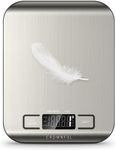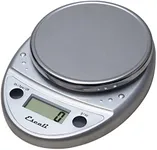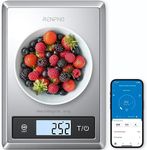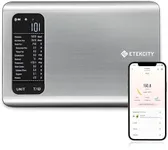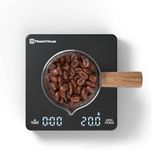Buying Guide for the Best Kitchen Scales
Choosing the right kitchen scale can make a big difference in your cooking and baking. A good kitchen scale helps you measure ingredients accurately, which is especially important for recipes that require precision. When picking a kitchen scale, think about how you plan to use it—whether for baking, portion control, or general cooking. Understanding the main features will help you find a scale that fits your needs and makes your time in the kitchen easier and more enjoyable.CapacityCapacity refers to the maximum weight the scale can measure. This is important because it determines what kinds of ingredients or containers you can weigh. Kitchen scales usually range from about 2 kg (4.4 lbs) to 10 kg (22 lbs). If you mostly weigh small amounts like spices or baking ingredients, a lower capacity is fine. If you want to weigh larger items or batches, look for a higher capacity. Think about the largest thing you might want to weigh and choose a scale that can handle it comfortably.
Accuracy and GraduationAccuracy is how close the scale's measurement is to the actual weight, and graduation is the smallest increment the scale can display (like 1 gram or 0.1 ounce). This matters because precise measurements are crucial for baking and portion control. Scales with finer graduations (like 0.1g) are best for small, delicate ingredients, while 1g increments are usually enough for general cooking. If you need to be very precise, such as for baking or coffee, choose a scale with smaller graduations.
Units of MeasurementMost kitchen scales can display weight in different units, such as grams, ounces, pounds, or milliliters. This is important if you use recipes from different countries or want to measure both solids and liquids. Some scales let you switch units easily with a button. If you often use international recipes or want flexibility, make sure the scale offers the units you need.
Tare FunctionThe tare function lets you reset the scale to zero after placing a container on it, so you only measure the weight of the ingredients. This is very useful for adding multiple ingredients into one bowl or for not having to do math to subtract the container's weight. Almost all digital kitchen scales have this feature, but it's good to check. If you like to mix everything in one bowl or use different containers, make sure your scale has a tare function.
Platform Size and MaterialThe platform is where you place your ingredients or containers. A larger platform can hold bigger bowls or plates, while a smaller one is more compact and easier to store. The material (like stainless steel, glass, or plastic) affects durability and how easy it is to clean. If you often weigh large items, choose a scale with a bigger, sturdy platform. If you want something easy to clean, look for smooth surfaces and materials that wipe down easily.
Display ReadabilityThe display shows the weight reading. A clear, easy-to-read display is important, especially if you work in a dim kitchen or use large bowls that might block the screen. Some displays are backlit for better visibility. If you have trouble seeing small numbers or often use the scale in low light, look for a scale with a large, bright display.
Power SourceKitchen scales can be powered by batteries, USB charging, or sometimes even solar power. Battery-powered scales are portable and easy to use, but you’ll need to replace batteries occasionally. USB-rechargeable scales are convenient if you don’t want to buy batteries. Think about what’s easiest for you—if you don’t want to worry about running out of power, check how long the scale lasts on a charge or how easy it is to replace batteries.
